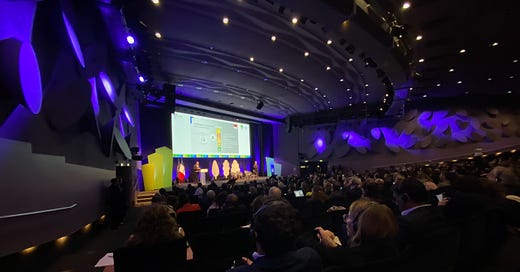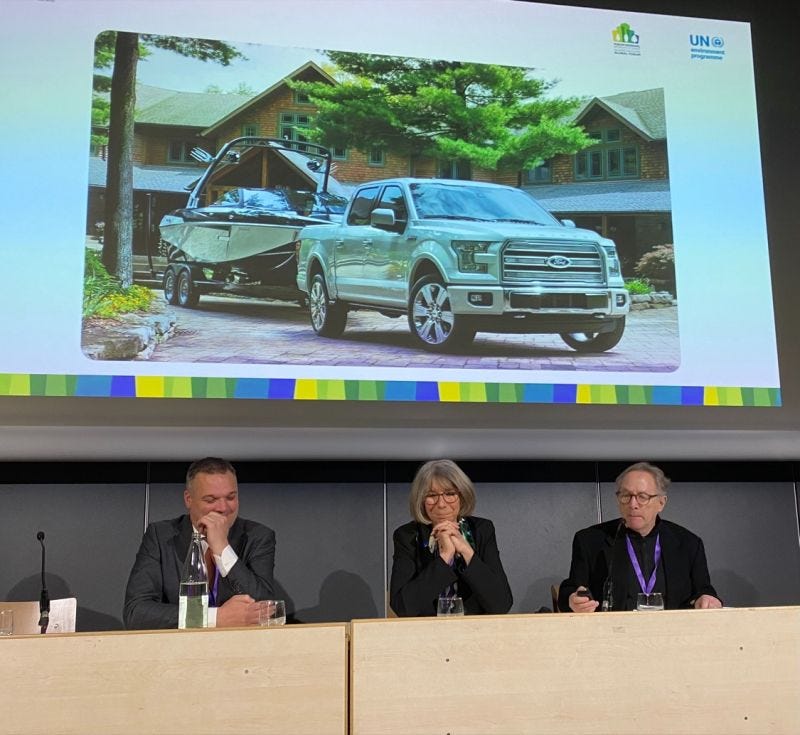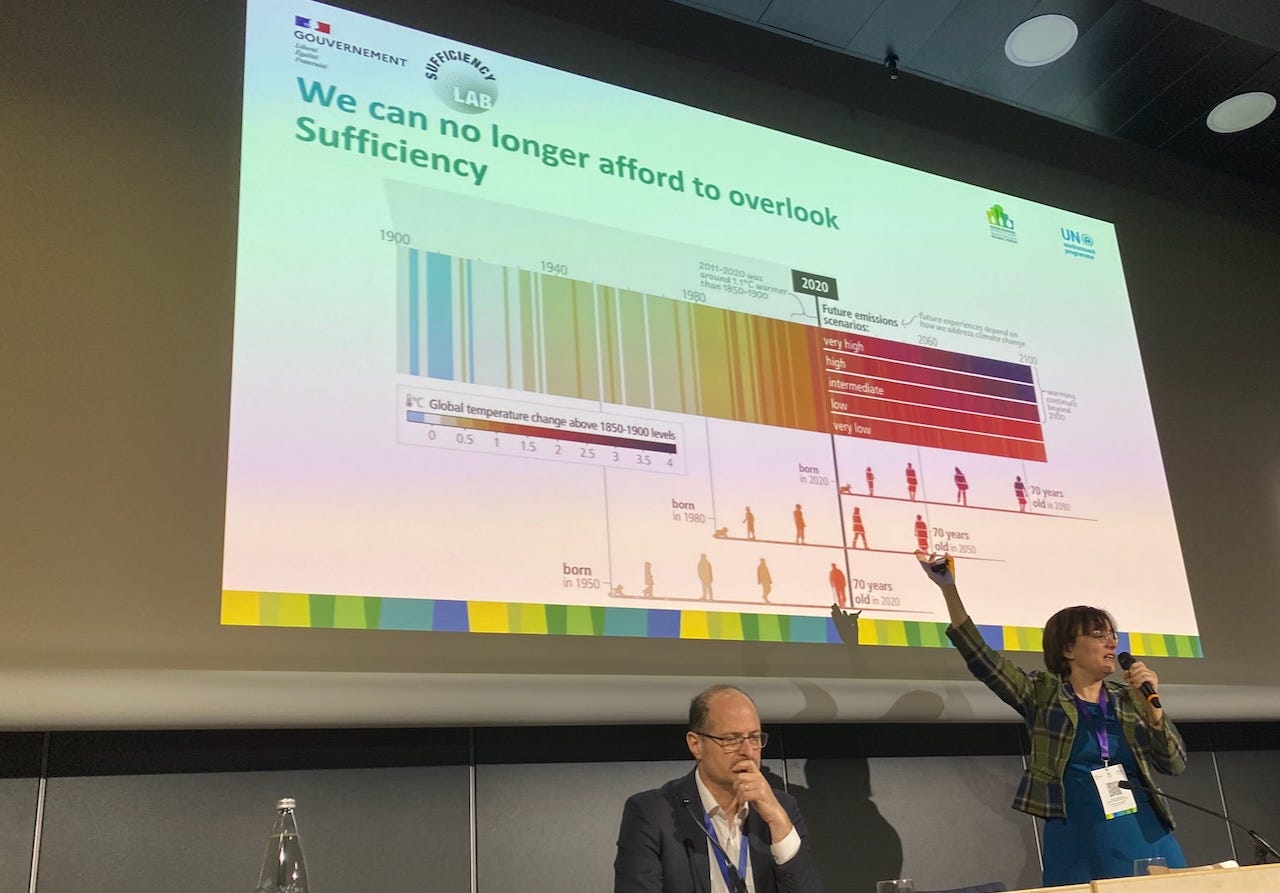The UNEP Conference on Buildings and Climate could make a real difference
They actually listened and came up with a serious document that puts sufficiency on the menu.
Well, it is official; I am part of a UN plot to change the building and planning sectors, having presented at the Buildings and Climate Forum in Paris on Thursday. I outlined my presentation in an earlier post, and had all of six minutes to get through 40 slides that left them a bit shell-shocked.
But it was really well received, especially since it was a bit less academic than the others on the panel.
I was honoured to meet Yamina Saheb, a pioneer in the concept of sufficiency and author of the section in the IPCC report that mentioned it, the first time sufficiency made it into an official document.
Some have complained that I shouldn’t have flown to Paris for this and should have presented virtually, but I was already coming to Europe for a Passivhaus conference next month where I am doing the closing plenary speech, you can’t do that virtually, and I stretched it out. Others have complained about the concept of sufficiency, defined by Yamina Saheb as “a set of policy measures and daily practices which avoid the demand for energy, materials, land, water, and other natural resources, while delivering wellbeing for all within planetary boundaries.” It’s controversial; people don’t like “avoiding demand” and discussing limits on consumption, and it wasn’t talked about in polite company until recently.
But it is now part of a Ministerial Declaration which aims “to create momentum for buildings decarbonisation and climate resilience by reinforcing international collaboration and making calls for commitments, both from governments and state and non-state actors in the building and construction sectors.” I asked specifically, what does this mean? Is it binding? Is it law? Nope, it is just a statement of principles and might be built into the next COP agreement. But I am proud to have been part of this.
The key section of the document calls for a transition in the planning/building industry with the following recommendations (sorry for all the quoting, but I find this so exciting to see in an official document that’s guidance for governments everywhere:)
Planning: These will anger certain Ontario politicians with a call for:
“Minimizing soil sealing and urban sprawl, loss of natural land, and surface area prioritising urban regeneration and the reuse of brownfields. Promoting dense, socially and functionally mixed-use spaces, inclusive and qualitative well-integrated neighbourhoods, notably to improve sustainable mobility.
‘Construction/Retrofitting: Prioritising the reuse, re-purposing and renovation of existing buildings and infrastructures to minimize the use of non-renewable resources, maximize and energy efficiency and achieving climate neutrality sustainability and safety with particular focus on the lowest performing buildings.”
“Prioritising integrated comprehensive design, retrofitting building structures and envelopes, and consistency between conception, construction and operation to ensure energy efficiency and a healthy indoor environment through passive means and, when needed, installing only highly energy-efficient systems, equipment and appliances.”
Accelerating building electrification in order to reduce direct emissions and conventional pollutants;
And my favourite grab-bag of every concept we talk about:
“Prioritising on-site assets, recycled and end-of-life use, local, sustainable, bio/geo-sourced, low carbon, energy efficient materials, products and components ensuring easy maintenance and repair for life extension, aligned with circular economy, eco-design and sufficiency and waste prevention principles, enhancing carbon balance through storage and absorption in building materials.”
And the last of three references to sufficiency:
“Enhancing energy demand flexibility, developing local grids at different levels to optimize renewable resources, and promoting energy saving behaviour and planning, including sufficiency, where appropriate.”
Will this result in meaningful change? Who knows. I can see the Premier of Ontario being “gobsmacked” by some UN official telling him he can’t do sprawl. Others will complain about electrification. We have been talking about all of this stuff for years and had very little impact.
But now it is all in an official document contributed to and supported by “1,000 representatives of state and non-state organisations involved in the buildings sector (engineering, construction, real estate) and 80 ministerial delegations from various governments.” And me.
I am looking for the online link to the entire document and will add it here when I find it.
It’s up, it’s the Declaration de Chaillot.






Thanks as always Lloyd for fighting the good fight. There are fewer deaf ears in the world as a result of your tenacity. In practice we do all we can to educate clients to renovate before new, electrify, and build for sufficiency arguing that a well designed house designed specifically for the client can be physically smaller and feel graciously accommodating. It helps that every square foot has an upfront first cost impact on budget and ongoing impact on operating costs:-) Keep up the great advocacy work!
"I am doing the closing plenary speech, you can’t do that virtually". One can do that vurtually. And in doing so provides dramatic leadership in calling for low-greenhouse-gas-emissions virtual conferences rather than high-greenhouse-gas-emissions physical conferences.